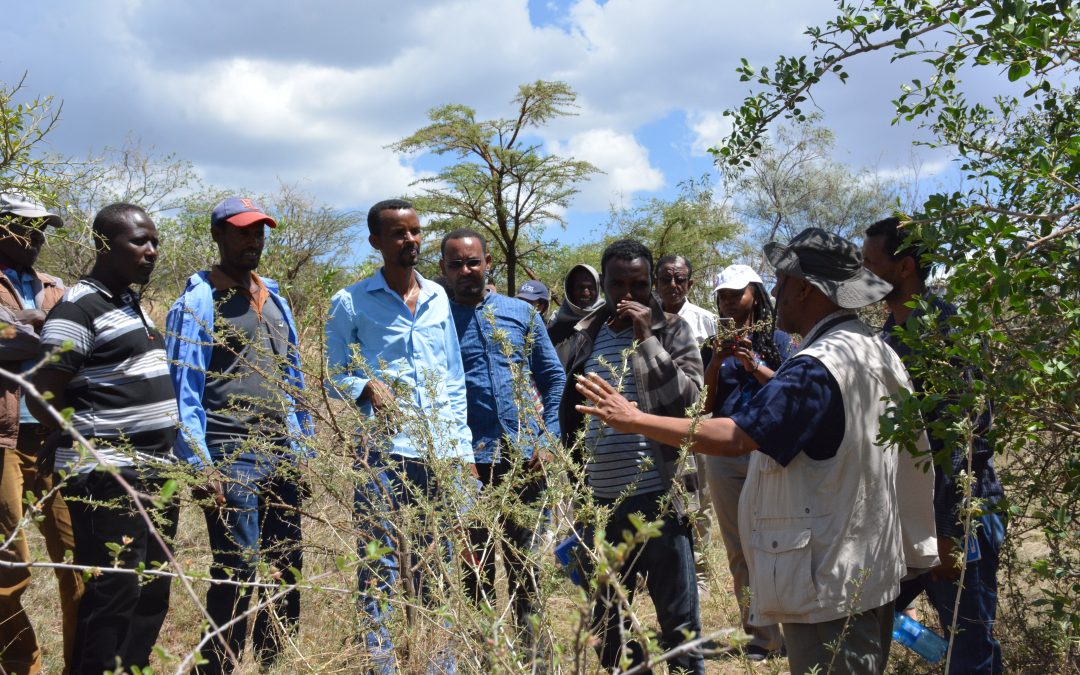By Grace Koech
Smallholders in Ethiopia are set to benefit from development of tree value-chains.
Smallholders in Ethiopia rely on trees and tree products for their livelihoods. According to the United Nations Environment Programme’s[1] report of 2016, income generated from woodfuel, fodder, honey, medicinal plants and roundwood contributed to 12.86% of Gross Domestic Product in Ethiopia in 2012.
The heavy reliance on trees can lead to environmental degradation, underscoring the need to enhance tree cover. Appreciating the finite nature of trees, Regreening Africa has included tree value-chains in its strategies to find ways to create incentives for farmers to benefit commercially from trees while regreening their environment. This approach is intended to improve the economic prospects of communities, generate more household income and increase profitability through better engagement with everyone along the tree value-chains.
Efforts to promote the approach started with a capacity-development and awareness-raising workshop, convened by Catholic Relief Services (CRS), World Vision Ethiopia (WVE) and World Agroforestry (ICRAF), convened the project’s key implementing partners in Ethiopia. The workshop, held 10–11 June 2019 in Ababa, Ethiopia engaged 22 project staff from all partner organizations.
Trainers Sammy Carsan from ICRAF HQ in Kenya, Muluken Demissie from WVE, and Hagazi Niguse from ICRAF Ethiopia set out the objectives of the training: to build the capacity of the implementing partners on value chain and marketing concepts, mapping of tree value-chain actors and how to develop a tree enterprise plan.
Carsan explained the concept of prioritized tree value-chains, challenges experienced when developing the chains and recommendations for overcoming them.
‘Prioritized value chains are typically woodfuel, timber and poles, honey, fodder, medicinal plants and fruits’, he said.

The participants assessed each of these and identified fodder, honey and poles for immediate implementation in their areas, agreeing that other chains required policy changes before being able to be implemented. The prioritised species were Cordia africana (‘awhi’) and Eucalyptus spp (‘barhir zaf’), Olea europea (olive), Ziziphus spina-christi (jujube), Ficus spp (fig), Rhamnus prinoides(‘gesho’), Opuntia ficus-indica (prickly pear), Diospyros mespliformis (jackalberry), Faidherbia albida(white acacia) and Acacia spp.
‘Value-chain enterprises must be profitable otherwise it’s not worth investing’, said Demissie, the value-chain expert at WVE.
Which is why it’s important to build capacity in marketing and in mapping influencers. With this knowledge, the next step is developing a business plan. Being a ‘living document’, a plan is prepared in a way that allows changes, always being updated, which clearly outlines the product marketing strategy, its operational plan, who to involve in managing the enterprise, how to ensure sustainable harvesting, contribution of the enterprise to social development, potential risks and mitigation measures and profit calculation and utilization plan.
Imparting this knowledge enables the trained staff to support enterprises to face the challenges against which smallholders struggle: low income from tree products owing to weak or no marketing, exploitation by brokers, and low quality of the products. Also, mapping key value-chain actors and aggregative marketing is expected to aid in linking the producers directly to markets and service providers for higher prices and better access to credit.
 As a way forward, the trainees were tasked to map all the stakeholders, assess challenges and information needs, then develop a business plan for their prioritized value chain. Further, to address the barriers that could prevent farmers from maximizing benefits derived from trees the following was recommended: building suitable partnerships, empowering farmers on tree management strategies and facilitating access to quality germplasm for better quality and quantity of tree products.
As a way forward, the trainees were tasked to map all the stakeholders, assess challenges and information needs, then develop a business plan for their prioritized value chain. Further, to address the barriers that could prevent farmers from maximizing benefits derived from trees the following was recommended: building suitable partnerships, empowering farmers on tree management strategies and facilitating access to quality germplasm for better quality and quantity of tree products.
Read the UNEP report
United Nations Environment Programme. 2016. The contribution of forests to national income in Ethiopia and linkages with REDD+. Nairobi, Kenya: United Nations Environment Programme.
About Regreening Africa
Regreening Africa is an ambitious five-year project that seeks to reverse land degradation among 500,000 households, and across 1 million hectares in eight countries in Sub-Saharan Africa. By incorporating trees into croplands, communal lands and pastoral areas, regreening efforts make it possible to reclaim Africa’s degraded landscapes.
This story was produced with the financial support of the European Union. Its contents are the sole responsibility of Regreening Africa and do not necessarily reflect the views of the European Union.

